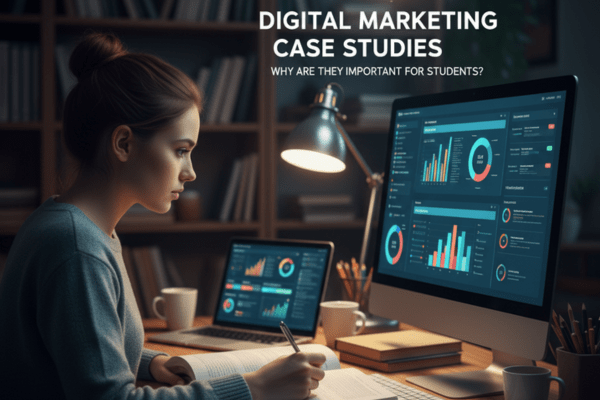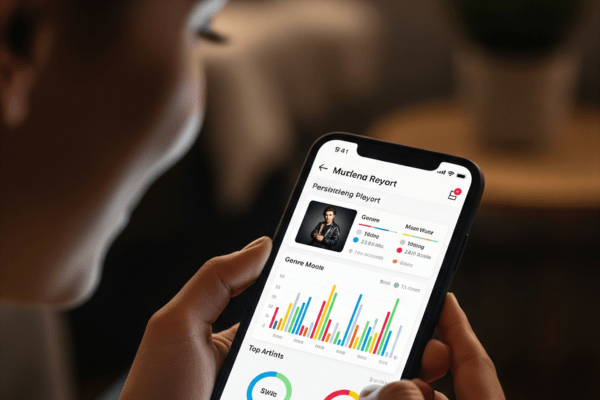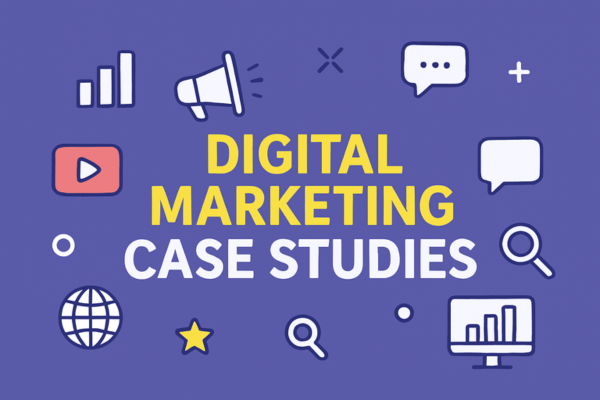If you are a student studying digital marketing case studies , you are most likely familiar with the term “case study”. But what exactly is it? A Digital marketing case study can be considered a comprehensive report of a company’s marketing journey. It’s not just a success story; it’s a complete documentation that presents a problem, the solution that was implemented, and the results that were achieved.
These kinds of narratives are incredibly valuable as they let you examine the scenarios outside of the textbooks. Instead of simply studying a concept like SEO or social media marketing, you see how a real company applied the concept to overcome a real problem and achieve significant results. It is like getting a backstage pass to the implementation of a successful marketing campaign.
Why are digital marketing case studies important for students?

Digital marketing student, theoretical knowledge is nice, but what counts is practical knowledge. This is exactly the point where digital marketing case studies take the stage. They function in the following ways:
Learning from success and failure: You have the opportunity of accessing the knowledge of what is effective and what is not. By delving into these cases, you come to grips with real-world challenges and solutions to beat them.
Linking Theory to Practice: You will learn digital marketing case studies like keyword research, viral marketing, and email campaigns are utilized in a real-world business context.
Going a Step Further with Theory Practice: The more you go through various marketing case studies, the more you realize how the different marketing channels you have learned work together.
Motivating Your Own Thoughts: The reading of these digital marketing case studies will awaken your imagination and will allow you to come up with new and original ideas for your next projects.
Top digital marketing case studies you should know.

Are you ready to jump in? Here are some of the most famous and insightful digital marketing case studies that every student should be familiar with. Each one talks about a different aspect of digital marketing case studies and gives a unique lesson.
Case Study 1: The Dollar Shave Club Viral Video
This is a quintessential instance of how a small and fresh company can challenge a long-established industry leader (for example Gillette Digital marketing case studies) with a smart and creative marketing campaign.
The Problem: Dollar Shave Club was a new subscription service that was selling razor blades. They had a very small budget and were going up against huge brands that had been around for a long time.
The Solution: Rather than going the traditional route and spending millions, they produced a hilarious and very low-budget video called “Our Blades Are Great.” The video was very straightforward, funny, and did not waste the viewer’s time. It was made for YouTube, not TV.
The Outcomes: The video went viral practically right away. Within a few days, it had millions of views. The company got a large number of new subscribers, and this one video made them go from being a minor player to a major brand.
Key Takeaways from Dollar Shave Club
This is a perfect example of one of the successful viral marketing campaigns. It demonstrates that reaching success does not require a huge budget. One only needs one creative, relatable, and sharable idea that is aimed directly at the target audience. Also, the video’s straightforward call-to-action was another factor contributing to its success.
Case Study 2: Coca-Cola’s “Share a Coke” Campaign
This is a story revolving around one of the most popular trends in marketing and that is personalization and user-generated content (digital marketing case studies).
The Problem: Coca-Cola wanted to reconnect with the younger audience and humanize its brand so that it would be more relevant and closer to the consumers.
The Solution: They substituted the well-known Coca-Cola logo on their bottles and cans with common first names and short phrases such as “Share a Coke with a friend.” They got people to find their names, take photos of the bottles on social media and use the hashtag Share A Coke, as well as to order personalized bottles online.
The Outcomes: The campaign was an enormous success. It got millions of social media mentions and sales surged. People loved the personalized aspect and they were eager to share their experiences.
Key Takeaways from “Share a Coke”
This case study is a handbook of how brands can employ social media and personalization as tools to create a community. By placing the customer at the core of the story, Coca-Cola ended up generating a vast pool of free, authentic marketing material.
Case Study 3: Airbnb’s User-Generated Content Strategy
The story of Airbnb is an excellent example of how user-generated content (UGC) can be leveraged to create trust and increase brand awareness.
The Problem: At the beginning of the journey, people were not very keen on the idea of staying at a stranger’s house. Trust was an issue and so Airbnb had to show the great and unique experiences that their service could offer to the consumers.
The Solution: They invited their customers to record their travel experiences and take pictures using hashtags like #Airbnb and #LiveThere. After that, they featured the most interesting content on their own social media pages and advertisements Digital marketing case studies.
The Outcomes: This strategy made it possible to gather a large pool of authentic, high-quality content which depicted real-life travel experiences. It made the brand more human, trustworthy and inspiring, thus there was a huge rise in booking.
Key Takeaways from Airbnb
It illustrates how your customers may act as your prime marketers. You produce trustworthy, relatable, and real content by inviting them to expose their experiences, and this content connects new customers far better than any traditional advertisement.
Case Study 4: Spotify’s Data-Driven Personalization
The example of Spotify shows how data can be used to create an incredibly personalized and engaging user experience.
The Challenge: As the market for music streaming was already saturated, Spotify was looking for a way to differentiate itself and retain its users.
The Strategy: They turned their user data into several features that are highly personalized such as playlists releases every week and the annual report. With these features, they monitor the daily habits of their users and hence suggest new music or offer a summary of the year which is short, fun, and easily shareable.
The Results: The two features got extremely popular. Every year, “Wrapped” gains a lot of followers, and the buzz is created mostly through the excitement of the users who are immediately eager to share it with their networks. This move made a strong bond between the company and its customers.
Key Takeaways from Spotify

It is a statement about the importance of data. By leveraging data to deliver an exceptional and sought-after experience, Spotify not only enhanced its offering but also created viral marketing ammunition.
Case Study 5: The “Old Spice” Campaign
This is an example of how an outdated and boring brand can be transformed into cool and relevant by a multichannel digital campaign.
The Challenge: Old Spice, men’s grooming product brand, was characterized as something from the past. The company wanted to attract people in their teens and twenties.
The Strategy: They started “The Man Your Man Could Smell Like” campaign with the hilarious “Old Spice Guy” as the face. The idea was to attract attention through a viral video. However, the true innovation was the follow-up. They personalized the video comments by responding through videos to reactions of fans, celebrities, and even other brands, some of which are comedic and others informative.
The Results: It received acclaim, considerably, translating to many millions of views and mentions and interactions with the brand multiply. The use of the campaign helped to give the old brand a new face and led the increase of Old Spice sales greatly.
Key Takeaways from “Old Spice”
Digital marketing case studies excellent example of a creative and multi-channel marketing campaign. It underlines the need for live interaction with the audience along with the use of YouTube, Twitter, etc., to produce user engagement and brand loyalty.
Case Study 6: Red Bull’s Content Marketing Strategy
Red Bull is not only a drinks company but it is also a media company that sells energy drinks.
The Challenge: Red Bull was only known for its product, so the company wanted the brand to be associated with excitement, adventure, and extreme sports instead.
The Strategy: They built a full-fledged content marketing program. Instead of running traditional ads, they made amazing videos, sponsored extreme events, and created a vast pool of content related to action sports, music, and adventure. One of their most notable projects was the Red Bull Stratos jump from outer space.
The Results: With this plan, Red Bull has become a name that is known for thrill and adventure at every household. Their content is viral most of the time and they have a group of fans who are faithful to the lifestyle that the brand represents.
Key Takeaways from Red Bull
This teaches one of the most valuable lessons: for a brand to survive and thrive in the current market environment, a brand must create value for its consumers beyond the simple provision of a product. By turning into a content creator and publisher, Red Bull became a brand that people connect with on an emotional level.
How to Analyze Digital Marketing Case Studies

When going through digital marketing case studies, do not simply skim them. In order to maximize your gain from these, please follow these guidelines:
Identify the Problem: What was the company’s main challenge or goal?
Understand the Audience: Who was the target audience for this campaign?
Break Down the Strategy: What specific digital marketing tactics did they use? (e.g., social media, video, email, SEO)
Examine the Results: What metrics were used to measure success? (e.g., views, sales, brand mentions, engagement)
Find the “Why”: Why did this particular strategy work? What was the key ingredient?
Conclusion: Your Path to Becoming a Digital Marketing Pro
It is more than just a class assignment to study digital marketing case studies – it is your secret weapon for success. These real-life stories teach you things that textbooks can’t. By learning why and how these campaigns got success, you are not simply reciting the facts but you are acquiring the critical thinking skills which are essential for a real digital marketer.
If you come across a successful ad or viral campaign in the future, don’t just move along, take time to look under the hood. Ask yourself, “What’s the story here?” This method will help you to develop the skill of turning challenges into opportunities and transforming ideas into successful campaigns. Keep learning, keep assessing and you’ll be well on your way to a fantastic career in digital marketing.
FAQS
Q. What is a digital marketing case study, and how is it different from a blog post?
Ans. A digital marketing case study is a comprehensive narrative describing a company’s marketing expedition. A blog post, in general, may teach or inform a concept, a case study unfolds a real-life issue, the exact digital marketing strategies a company employed to resolve it, and the precise outcomes they achieved. It’s a way of showing a successful campaign from behind the scenes.
Q. As a student, why should I spend time reading digital marketing case studies?
Ans. Case studies are an absolute must-have in your learning toolkit as they provide a vital link between what is taught in textbooks and what actually happens in the market. You’ll get to know through the ups and downs of mighty brands, get acquainted with the manner in which the different marketing channels interact and be motivated to come up with your own original ideas of the campaigns. This is hands-down the most effective way to master real-world skills and gear up for your future path of career.
Q. Where can I find good digital marketing case studies to learn from?
Ans. A number of places are awash with digital marketing case studies you can use to learn from. Start by exploring the websites of renowned digital marketing agencies looking for their official case study section and also checking out industry blogs like HubSpot, Neil Patel, or SEMrush. Additionally, many companies publish their campaign results in their blogs or in press releases.
Q. How can I use a digital marketing case study to improve my own skills?
Ans. Don’t just read the case-the story-analyze it! First find out the company’s primary objective. After that deconstruct the strategies they used in detail. Look at and analyze the key results of the campaign to figure out why the method they adopted was very successful. By doing so, you will also hone your critical thinking skills which are one of the key skills of any digital marketer.
Q. Is it only the stories of the big, famous companies that are digital marketing case studies?
Ans. Not necessarily! Although the big brands like Coca-Cola and Red Bull are a great source of learning, some of the most motivating digital marketing case studies are the ones of small businesses or startups which grow exponentially with a limited budget. These cases usually show that creativity and clever winning of strategy are more powerful than just having plenty of money.

